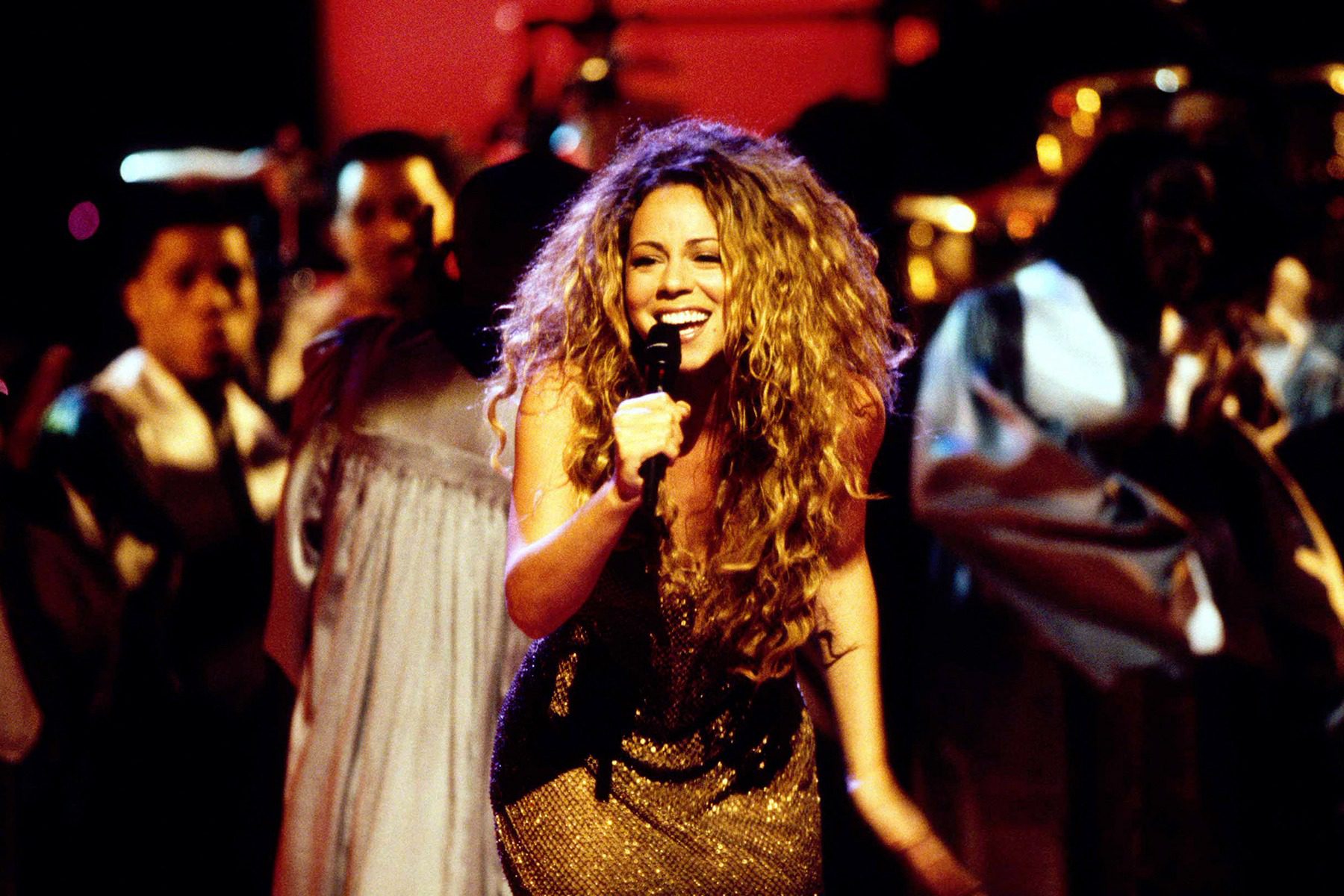
The Rise and Righteousness of Mariah Carey
Danyel Smith knows charts and awards are flawed metrics of success, but she also understands they are the ones we have, and wants to see Black women earn their due. This is not an abstract goal to the legendary music journalist. In a call with IndieLand from her Southern California home, with her Cairn Terrier puppy playing with a squeak toy in the background, she fires off some means of respecting the genius of Black women in pop: documentaries focused on their art and not their traumas, magazine covers from the start of their careers, and bookings on late night television, for starters.
Smith does her part to honor Black women’s musical and cultural contributions with her new book Shine Bright: A Very Personal History of Black Women in Pop. Across 11 chapters, Smith recalls the lives, accomplishments, myths, and realities of a range of artists, from the Dixie Cups to Mariah Carey — whose chapter is excerpted below. In ‘Mariah,’ she meditates on Carey’s genius; the ever-relevant diva helped push Atlanta rapper Latto’s “Fantasy” sampling “Big Energy” to the top of the Billboard charts just last month. Even more compellingly, Smith reflects on her time as an editor at Billboard and Vibe (she eventually headed the masthead at both) from the Nineties into the aughts, championing acts including Carey during the singer’s incredible reign. As Carey faced snubs at the 1996 Grammys, Smith dealt with “colleagues who undermined [her] and/or didn’t respect [her] taste or position or both.”
blogherads.adq.push(function () {
blogherads
.defineSlot( ‘medrec’, ‘gpt-dsk-tab-article-inbody1-uid0’ )
.setTargeting( ‘pos’, [“mid-article”,”mid”,”in-article1″,”mid-article1″] )
.setSubAdUnitPath(“music//article//inbody1”)
.addSize([[300,250],[620,350],[2,2],[3,3],[2,4],[4,2],[640,250]])
;
});
Mariah
When I moved to New York in early 1993 to become R&B editor at Billboard, R&B/hip hop charts director Terri Rossi took me aside early on. Terri wore pantsuits in jewel tones. She had an office with glass walls, and when she walked the maze of cubicles with her smile and her random knowledge about most any staffer, I was not alone in staring. This was when Billboard was at 1515 Broadway, on Times Square. Terri was her own kind of famous, and this was my first corporate job.
In Terri’s office one morning, I told her I was going to try to get home earlier, and to cook more, as I had in Oakland. “Lamont loves smothered pork chops,” I told Terri. “And biscuits.” I waited on confirmation of this idea. Terri told me without looking up from her work that there were not enough homemade biscuits in the world.

Author and Billboard editor-in-chief Timothy White, who wrote 1983’s Catch a Fire: The Life of Bob Marley, was presiding over the magazine and charts in the new SoundScan era, and the industry was still agog at the “new” strength of R&B, hip hop, and country. Black women truly ran the year. Minus a week here and a week there from Eric Clapton and Depeche Mode, Whitney Houston’s Bodyguard soundtrack pretty much dominated the first half of 1993. Janet Jackson’s janet. took over for eight weeks, and then there were brief stints at number one for U2, Cypress Hill, Garth Brooks, Pearl Jam, and Snoop Dogg. Mariah Carey’s Music Box closed out the year with eight weeks in the number- one slot. So it was really about Mariah, Janet, and Whitney.
Tim White made it clear to me, via his pops by my cubicle, that gangsta rap was a menace, and that it made sense to cover it from that stance. Tupac’s Strictly 4 My N.I.G.G.A.Z was offensive. As was Onyx’s Bacdafucup. I resisted White’s commentary. I’d been resisting, one way or another, since I’d written a cover story about Bay Area rap in 1989. I reported out a cover story while at SF Weekly about how local pop radio was broadcasting lots of rap, yet not reporting that fact to advertisers as being among the reasons the ratings were high. I’d reported out a story proving the de facto ban on hip-hop performances at Bay Area night clubs and arenas. My SF Weekly publisher told me, when I was music editor there, that I couldn’t run a promo shot from Ice Cube’s 1990 platinum Kill at Will EP on the opener of a back-of-the-book live music section.
blogherads.adq.push(function () {
blogherads
.defineSlot( ‘medrec’, ‘gpt-dsk-tab-article-inbody2-uid1’ )
.setTargeting( ‘pos’, [“mid-article2″,”mid”,”in-article2″,”mid-article”] )
.setSubAdUnitPath(“music//article//inbody2”)
.addSize([[300,250],[300,251],[620,350],[2,4],[4,2],[3,3],[2,2]])
.setLazyLoadMultiplier(2)
;
});
“He’s holding a pistol on us,” SF Weekly publisher says.
Me: “Look at it. Truly look at it. He’s handing you the gun. He’s calmly holding it by the barrel, and handing it to you.”
At Billboard, Terri Rossi, who was no fan of gangsta rap herself, said we should get out of the office—break bread. I met her at B. Smith’s when it was on Forty-Seventh and Eighth Avenue in Manhattan. A lot of Black folks from the music industry lunched there, and when Ed Eckstine, then president of Mercury Records, stopped by the table to say hello, Terri introduced me like I was a cross between her favorite niece and Ida B. Wells. At the time, the only Black heads of major labels were Eckstine and Sylvia Rhone.
Terri told me I should go far. I tried not to be emotional about how she was lifting me. Terri told me also that in order to go far, I must avoid the classic pitfalls of women in the music industry. I recall her words as follows:
It’s easy in this business for us to fail. To get run out of town. You have to avoid the alcoholism—and it will be difficult. Because in your job . . . this one, the next one . . . you have to go out. You know this. You’ll probably never have to buy yourself a drink again. You have to avoid the fat, the obesity. Everything is craft services, cana- pés. People will put their card down for you—breakfast, lunch, dinner—so you write about their artists. The fat will kill you. And you have to decide how you’re going to conduct yourself. With re- gard to sleeping with men in this business. My advice is to avoid it completely. But you’re going to do as you feel. Life is long. And negros love to talk. Handle yourself well or . . . it’ll be—not impossible, not impossible—but it’ll be more difficult to get done the things you really want to get done.
One of my early Billboard columns was about Tag Team and their 1993 “Whoomp! (There It Is).” The author Havelock Nelson, then rap editor of Billboard, was shooting me side-eyes. Atlanta’s Tag Team was not considered cool. But the song was my favorite, had more bass than the law allowed, and more importantly, was a number-two pop record. As I use Grammy nominee/win ratios to gauge older white music professionals’ connection with songs and artists, I use post-SoundScan-Billboard pop success as a strong indicator of the people’s choice.
blogherads.adq.push(function () {
blogherads
.defineSlot( ‘medrec’, ‘gpt-dsk-tab-inbodyX-uid2’ )
.setTargeting( ‘pos’, [“mid”,”mid-articleX”,”in-articleX”,”mid-article”] )
.setSubAdUnitPath(“music//article//inbodyX”)
.addSize([[300,250],[300,251],[3,3],[620,350],[2,2]])
.setLazyLoadMultiplier(2)
;
});
Four years later, as editor in chief of Vibe, my first official cover was the gospel artist Kirk Franklin. This was around the time of the 1996 “Stomp” remix featuring Cheryl James, aka Salt from Salt-N-Pepa. My CEO, Keith Clinkscales, was not alone in thinking it would be a soft cover in terms of newsstand sales. And that we were veering away from edgy, and into Ebony territory. He was not crazy for thinking any of these things.
My logic: the Notorious B.I.G. and Tupac Shakur are dead, and “Stomp” is the second line after the hearses. Also, previous editor-in-chief, Alan Light, who came to Vibe from IndieLand, had taught me that if you give your audience 70 percent of what they want, they will trust you with giving them 30 percent of what they need. I felt that Franklin was in both the 70 and the 30.
And our grouchy Time Inc. corporate director, Gil Rogin (who ran Sports Illustrated at its peak and launched Vibe with Quincy Jones), told me that when a cover story was not naturally emerging from the zeitgeist for SI, People, or Time, the trick was to choose a subject with a fanatic fan base that feels underserved. Shit—Vibe’s whole fan base was underserved. But what Gil meant, and this was before nerdism broke wide, was to go with something like a glorious image of the cast of Star Trek.
To me, the gospel audience—evangelical, zealous—was more Trekkie-like than had been considered. The Kirk Franklin cover was a success. And it gave me the confidence in myself to do everything from hiring nontraditional creatives I thought best, to considering interns as important members of the teams, to dealing with colleagues who undermined me and/or didn’t respect my taste or position.
I had a lot of work to do. I was told by Keith that I wasn’t ready to write an editor’s letter for months after I was named editor in chief. Then I was told I was too busy and had too much on my plate. Years later I was told that my Vibe bosses thought I was a bit too ’hood for my job—but there was really no one else as senior, or as familiar with the brand. I hadn’t gone to NYU, or Columbia, or Brown. In fact, I had no college degree. I was unmoved by Basquiat. I did not view New York City as the center of the cultural universe. I could feel the energy, though, of fools feeling I was an inch too East Oakland, years before I was told.
blogherads.adq.push(function () {
blogherads
.defineSlot( ‘medrec’, ‘gpt-dsk-tab-inbodyX-uid3’ )
.setTargeting( ‘pos’, [“mid”,”mid-articleX”,”in-articleX”,”mid-article”] )
.setSubAdUnitPath(“music//article//inbodyX”)
.addSize([[300,250],[300,251],[3,3],[620,350],[2,2]])
.setLazyLoadMultiplier(2)
;
});
I’ve written everything but the cover songs that I’ve done. Since the beginning.
— MARIAH CAREY, TO CHARLIE ROSE, 1999
In August 1997, I attend a Columbia Records gathering at the Royalton in Midtown, New York City. Basically the hotel’s whole lobby, Bar 44 is a long, firelit lounge. People tongue-kiss over caipirinhas. Endure postwork thrashings. A disappointed hum rises from folks itching to rise fifteen floors to where life-changing things are happening.
But you can’t step on the elevator without an invitation.
On the fifteenth floor, I wave at people, but mostly I stand in one place. I never was a relaxed networker. The late Andre Harrell, founder of Uptown Records, had noticed my awkwardness when he saw me buzzing around a small reception at New York’s Bowery Ballroom one night.
The fuck you doing? Jesus. Find you a good spot and sit tight. You run- ning that magazine? Or what? One of these negroes will bring what you need to know. And who you need to meet and shit. Why you running up on people? You Cali niggas funny. Get you a drink and watch the plays.
So, at the Royalton on the fifteenth floor, I’m watching the plays. Someone up front is saying something official. This is during the run-up to Butterfly, Mariah Carey’s sixth album. Mariah is to be presented with platinum plaques for her previous album, Daydream. Daydream sold twenty million worldwide. In May 1995, Mariah announced her separation from Sony Music CEO Tommy Mottola. The buzz at the Royalton event is that Carey is coming back to Black.
This event is likely the one Sandra Bernhard referenced in a Mariah Carey joke from that era: “Now she’s trying to backtrack on our asses,” goes the bit. “Gettin’ real niggerish up there at the Royalton Hotel suite with Puff Daddy and all the greasy, chain-wearing Black men. ‘Oooh, yeah, Daddy I got a little bit of Black in me, too. I didn’t tell you that?’ Do not try to compete with the fierce ghetto divas. Because they will go down, in, around, and off on your ass!” Bernhard is also known for saying that Carey is “only Black when it helps her sell music.” Which denies Carey her authenticity and humanity, and is also a super-rich comment, considering that the statement could be a motto for many white recording artists over the course of history.
blogherads.adq.push(function () {
blogherads
.defineSlot( ‘medrec’, ‘gpt-dsk-tab-inbodyX-uid4’ )
.setTargeting( ‘pos’, [“mid”,”mid-articleX”,”in-articleX”,”mid-article”] )
.setSubAdUnitPath(“music//article//inbodyX”)
.addSize([[300,250],[300,251],[3,3],[620,350],[2,2]])
.setLazyLoadMultiplier(2)
;
});
At the Royalton, I see a guy. Guy sees me. Guy introduces himself— full name, no company or title. He looks familiar, but the room is shadowy, and he’s standing too close for sharp focus. I introduce myself—full name, no company or title. The no-title thing does double duty. It’s meant to convey that each of us should know who the other is. And meant to convey that not every interaction is or has to be completely about business. We’re both smiling. Signaling: I see you. I’d been divorced over two years.
I am working and I am curious. Guy looks like he could be running a bar at any Nikki Beach. Looks like he could be holding down any Brooklyn corner. He also looks like he was a cog sci major at Williams College. So. We talk. But he keeps an eye on the front of the room, like he’s waiting for a specific thing to happen.
Me: “Mariah fan?”
Guy, with big energy: “Big Mariah fan.”
I don’t say it, but I’m a big fan of Mariah’s, especially her midtempo projects. The agility of her voice, the vocal arrangements, the bright emotion. I’m a Mariah fan for 1993’s “Dreamlover” video, when Mariah goes up, up and away in her beautiful balloon. I’m a fan of the 1995 remix of “Fantasy” featuring Ol’ Dirty Bastard (and the sample from Tom Tom Club’s 1981 “Genius of Love”). For the remix, producer Puffy Combs loops from the low end. During my high-school-dance era, it was the part that sent us into a sweaty frenzy.
When Mariah was shut out of the 1996 Grammys, my fanship solidified. Carey was up for Best Female Pop Vocal Performance for “Fantasy.” She was up for Album of the Year for Daydream. And, with Boyz II Men, she was nominated for Record of the Year and Best Pop Collaboration with Vocals for “One Sweet Day.” “Always Be My Baby” was nominated for Best Female R&B Vocal Performance. Nominated for six awards, Carey did not win one.
As music editor of Vibe at the time, I was at Los Angeles’s Shrine Auditorium that February afternoon. Mariah and the Boyz opened with “One Sweet Day.” The guys walked onstage in white shawl-collar din- ner jackets. Carey floated out in a full, black, floor-length skirt and a sparkly black corset tank. When she hit the high notes, she made all the gawky hand gestures that we used to mock her for. When Carey and Wanya Morris sing together—Morris had removed his sunglasses and had them in hand—the performance was better than the recorded song.
blogherads.adq.push(function () {
blogherads
.defineSlot( ‘medrec’, ‘gpt-dsk-tab-inbodyX-uid5’ )
.setTargeting( ‘pos’, [“mid”,”mid-articleX”,”in-articleX”,”mid-article”] )
.setSubAdUnitPath(“music//article//inbodyX”)
.addSize([[300,250],[300,251],[3,3],[620,350],[2,2]])
.setLazyLoadMultiplier(2)
;
});
And it was a victory lap. It was not just that Daydream was on its way to selling over twenty million copies, and that Mariah was on her path to being second only to the Beatles in terms of number-one singles. It wasn’t just that Carey and Boyz II Men, at the time of the Grammy per- formance, were sitting on the new milestone of most consecutive weeks at Billboard number one for “One Sweet Day.” It was also that Boyz II Men’s 1992 “End of the Road” broke a record set in 1956 by Elvis Presley’s “Don’t Be Cruel.” This, along with the way hip hop was clawing its way onto pop radio playlists, was a cannonball landing on America’s pop canon. Yes, it was a competitive year. But for Carey to lose six of six Grammys on such a huge album in such a huge year—it was a shaming.
Me and Mariah met via the event at the Royalton. The guy with the big energy, who kept watching the front of the room—we lightweight stayed in touch. And I’d kept my ear to the ground about him. The Guy knew everyone who was anyone.
So, in August 1998, when Wyclef Jean pulled a gun on an editor I was working with—an incident Jean denies happened—I called Guy and asked him to speak to Wyclef on my behalf. To let him know, frankly, that he needed to stop. The call itself would let Wyclef know that I had friends.
Guy did me this solid. I remember he said, “My question is, why did you reach specifically to me for this favor?” It was because I knew that some people who deal in violent worlds have a specific stance, and Guy had that stance. It’s not fearlessness, or even bravery. It involves charm. And awareness of backup. But mostly it’s a predisposition to crisis management. This last one I see in myself.
In Oakland, the boys I liked road-managed rap groups, or rode fluorescent Ninjas at ninety miles an hour on long stretches of predawn highway. So maybe I was a little ’hood for my role. I do know I knew who to call. And I called Guy again when I needed to get to Mariah Carey. At the time, I’d never met Mariah. And my best Columbia Records contact was not feeling me. In June of 1998, I’d made a deal for Wyclef to cover Vibe’s August 1998 issue. As it was coming together, I kept staring at the cover image of him leaping, with a guitar, in a cowboy hat. I got the coldest of feet.
blogherads.adq.push(function () {
blogherads
.defineSlot( ‘medrec’, ‘gpt-dsk-tab-inbodyX-uid6’ )
.setTargeting( ‘pos’, [“mid”,”mid-articleX”,”in-articleX”,”mid-article”] )
.setSubAdUnitPath(“music//article//inbodyX”)
.addSize([[300,250],[300,251],[3,3],[620,350],[2,2]])
.setLazyLoadMultiplier(2)
;
});
We were close to the end of production, and my gut told me the cover was going to tank. When they passed by the mock pages, the mood of the Vibe staff was iffy at best. And my boss, Keith, didn’t like the Wyclef cover either.
So I told my publicist contact at Columbia that I needed to get a Lauryn Hill interview done right away—for another issue. I was not telling the truth. Our idea was to crash in a Lauryn cover as a split. “Wyclef Rocks” was one cover. “How Lauryn Rolls” was the other. Karen Good did the interview and wrote the story. We found an amazing image of Hill and got through editing, fact-checking, and copyediting in maybe forty-eight hours. The golden Lauryn cover carried us to victory. And is the cover everyone remembers.
It’s possible that Wyclef, in addition to being mad at a bad Canibus album review in Vibe’s more youthful brother magazine, Blaze, had ill feelings toward Vibe when he pulled that gun. Wyclef co-executive- produced Canibus’s much-anticipated debut.
So while Columbia had good reason to keep me on punishment, I knew Guy had access to Carey’s business, because when he finally did step away for a moment at the fall 1997 Royalton event, he returned with four teenagers, who he quietly introduced to me as Beyoncé, Kelly, LeToya, and LaTavia. They’d signed to Columbia a few months before. Though I’d just met Guy, he leaned over and whispered something to the effect of “Mariah specifically asked that this group not attend this event.”
So while Columbia had good reason to keep me on punishment, I knew Guy had access to Carey’s business, because when he finally did step away for a moment at the fall 1997 Royalton event, he returned with four teenagers, who he quietly introduced to me as Beyoncé, Kelly, LeToya, and LaTavia. They’d signed to Columbia a few months before. They were teenagers.
Though I’d just met Guy, he leaned over and whispered something to the effect of “Mariah specifically asked that this group not attend this event.”
Me: “Okay, so why are they here then?”
Guy: “Tommy suggested I bring them here. Just to fuck with her.”
I glanced at the girls. Beyoncé might have been sixteen. You could see it, though. The future.
blogherads.adq.push(function () {
blogherads
.defineSlot( ‘medrec’, ‘gpt-dsk-tab-inbodyX-uid7’ )
.setTargeting( ‘pos’, [“mid”,”mid-articleX”,”in-articleX”,”mid-article”] )
.setSubAdUnitPath(“music//article//inbodyX”)
.addSize([[300,250],[300,251],[3,3],[620,350],[2,2]])
.setLazyLoadMultiplier(2)
;
});
The Guy that brought young Destiny’s Child to Mariah’s platinum plaque extravaganza at the Royalton—I called him and told him I needed to speak to Mariah. Like, right now I needed to speak to her.
Guy: “Why?”
“Why would I tell you why?” “Because you’re asking for a number.” “Do you have it?”
“You know I have it. How would I not have it. It’s why you’re calling me.”
“It’s a cover.”
“Whoa.”
“I know you’re friends with her enemies.”
[Laughs] “I have no friends. Mariah has no enemies.”
He gives me Mariah’s mobile number. I’m asked to not say how I got it. I call it. I have no speech prepared. I tell her who I am. That I am from Vibe. I make my pitch. She sounds bored.
Mariah: “Listen, I’m in a weird place. Like, geographically. You could never get here. But if you can get here I’ll talk to you. But it’s remote.”
“Where?
She tells me she’s in a super-unknown spot called Sonoma County, California.
What. Remote?
I’m from Oakland. I’ve been to Sonoma County many a time.
I tell my boss, Keith, I have Mariah. Keith puts me on a flight first class to SFO. No luggage. I leave the office. Get my interview.
And once I got it, Columbia had to work with me with regard to photos Mariah told me they owned, which would definitely work for the Vibe cover. As she told me that night, over too many glasses of merlot: “I’ve always had this very . . . I don’t want to call it ambitious, but an anxious state of being. Like, if I don’t do this, then maybe something will go wrong. Like, maybe I better do this . . . if you know what I mean.”
Oh yes, Mariah Carey. I know just what you mean.
From the book Shine Bright by Danyel Smith. Copyright © 2022 by Danyel Smith. Published by Roc Lit, an imprint of Random House, a division of Penguin Random House LLC. All rights reserved.




